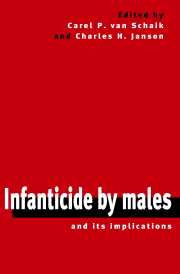23 results
Primate group size, brains and communication: A New World perspective
-
- Journal:
- Behavioral and Brain Sciences / Volume 16 / Issue 4 / December 1993
- Published online by Cambridge University Press:
- 04 February 2010, pp. 711-712
-
- Article
- Export citation
References
-
- Book:
- Infanticide by Males and its Implications
- Published online:
- 04 November 2009
- Print publication:
- 02 November 2000, pp 495-554
-
- Chapter
- Export citation
Subject index
-
- Book:
- Infanticide by Males and its Implications
- Published online:
- 04 November 2009
- Print publication:
- 02 November 2000, pp 565-569
-
- Chapter
- Export citation
Part III - Behavioral consequences of infanticide by males
-
- Book:
- Infanticide by Males and its Implications
- Published online:
- 04 November 2009
- Print publication:
- 02 November 2000, pp 221-222
-
- Chapter
- Export citation
19 - The behavioral ecology of infanticide by males
-
-
- Book:
- Infanticide by Males and its Implications
- Published online:
- 04 November 2009
- Print publication:
- 02 November 2000, pp 469-494
-
- Chapter
- Export citation
List of Contributors
-
- Book:
- Infanticide by Males and its Implications
- Published online:
- 04 November 2009
- Print publication:
- 02 November 2000, pp viii-x
-
- Chapter
- Export citation

Infanticide by Males and its Implications
-
- Published online:
- 04 November 2009
- Print publication:
- 02 November 2000
Part I - Introduction
-
- Book:
- Infanticide by Males and its Implications
- Published online:
- 04 November 2009
- Print publication:
- 02 November 2000, pp 7-8
-
- Chapter
- Export citation
Species index
-
- Book:
- Infanticide by Males and its Implications
- Published online:
- 04 November 2009
- Print publication:
- 02 November 2000, pp 555-564
-
- Chapter
- Export citation
Part II - Infanticide by males: case studies
-
- Book:
- Infanticide by Males and its Implications
- Published online:
- 04 November 2009
- Print publication:
- 02 November 2000, pp 73-74
-
- Chapter
- Export citation
Infanticide by males: prospectus
-
- Book:
- Infanticide by Males and its Implications
- Published online:
- 04 November 2009
- Print publication:
- 02 November 2000, pp 1-6
-
- Chapter
- Export citation
Part IV - Infanticide by females
-
- Book:
- Infanticide by Males and its Implications
- Published online:
- 04 November 2009
- Print publication:
- 02 November 2000, pp 421-422
-
- Chapter
- Export citation
Frontmatter
-
- Book:
- Infanticide by Males and its Implications
- Published online:
- 04 November 2009
- Print publication:
- 02 November 2000, pp i-iv
-
- Chapter
- Export citation
Part V - Conclusion
-
- Book:
- Infanticide by Males and its Implications
- Published online:
- 04 November 2009
- Print publication:
- 02 November 2000, pp 467-468
-
- Chapter
- Export citation
4 - Infanticide in red howlers: female group size, male membership, and a possible link to folivory
-
-
- Book:
- Infanticide by Males and its Implications
- Published online:
- 04 November 2009
- Print publication:
- 02 November 2000, pp 75-98
-
- Chapter
- Export citation
Contents
-
- Book:
- Infanticide by Males and its Implications
- Published online:
- 04 November 2009
- Print publication:
- 02 November 2000, pp v-vii
-
- Chapter
- Export citation
14 - Resources and primate community structure
-
-
- Book:
- Primate Communities
- Published online:
- 21 August 2009
- Print publication:
- 14 October 1999, pp 237-267
-
- Chapter
- Export citation
11 - Comparing communities
-
-
- Book:
- Primate Communities
- Published online:
- 21 August 2009
- Print publication:
- 14 October 1999, pp 189-190
-
- Chapter
- Export citation
5 - Primate diversity
-
-
- Book:
- Primate Communities
- Published online:
- 21 August 2009
- Print publication:
- 14 October 1999, pp 90-91
-
- Chapter
- Export citation
16 - Spatial and temporal scales in primate community structure
-
-
- Book:
- Primate Communities
- Published online:
- 21 August 2009
- Print publication:
- 14 October 1999, pp 284-288
-
- Chapter
- Export citation



